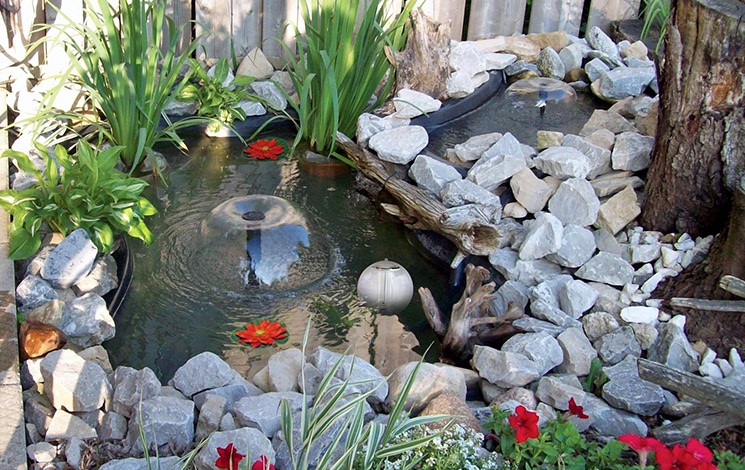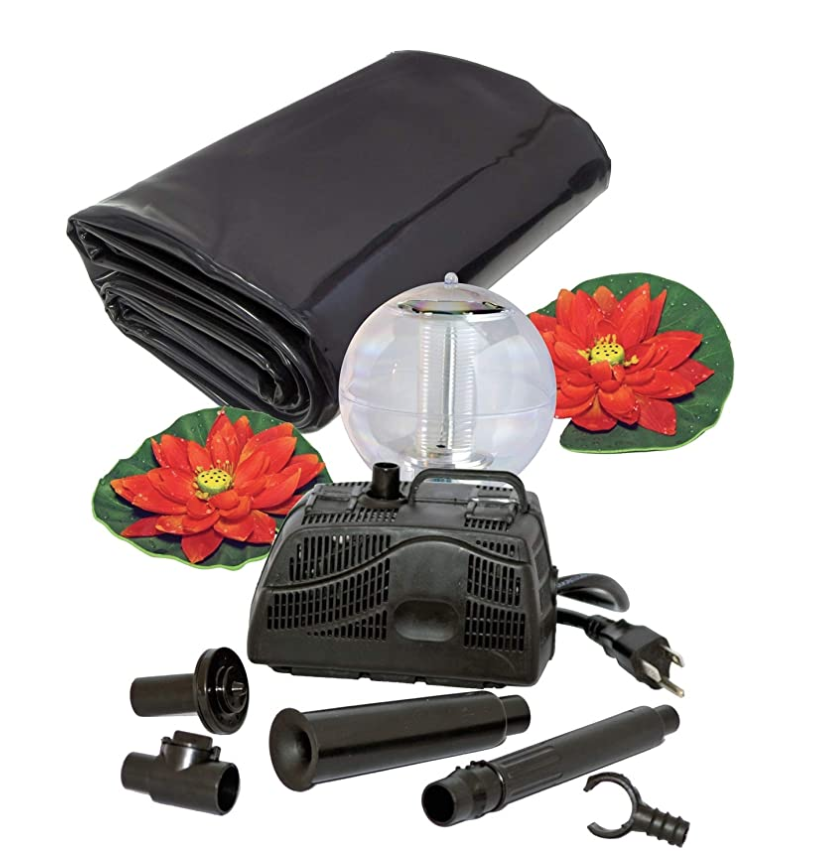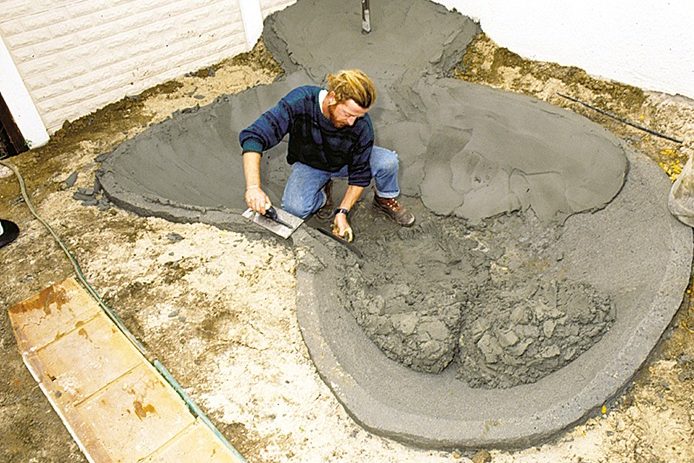
All About Buying Koi Pond Kits
Koi Pond Kits are central if you are planning a koi pond, it will pay you to find out as much as possible about koi fish and types of ponds that are suitable for keeping koi successfully. Amongst other things, you need to be sure of the type of pond that will suit your needs, in terms of both size and structure, as well as the equipment that will allow them to thrive.
Generally, you can keep koi in any pond that is large enough for the number and size of the fish you plan to keep. This means that the construction method you decide to use must allow you to build a pond that is big enough. Most preformed ponds are on the small side, so unless you are only going to keep just a couple of koi, this is not going to be a suitable type. Flexible koi pond kits liners may be used to build larger ponds, or you can use concrete to construct them.
This is a sample of what you might get when you order DIY Koi Pond Kits ‘Click the pic above’ to check the price.
DIY With Koi Pond Kits
If you are into DIY and don’t want to employ a company to do the work for you, you should have a look at what koi pond kits are available. These normally offer all the pond construction equipment you need to build your own koi pond. The most usual types come with a flexible pond liner, and you will find them alongside most other fish pond supplies. But be sure to compare different kits accurately. Make sure you know what materials and equipment you will be getting, and how much you will pay for it. Pump sizes may vary and so may filter types.
What to Expect From Koi Pond Kits
Here’s an example of what you might get in quality koi pond kits:
- an energy-efficient pond pump,
- a biological filter (to keep the water in your pond clear and clean),
- a skimmer unit usually with filter brushes,
- all the plumbing components (including pipes and connectors) you need to install the pump and filter,
- a skimmer box,
- a cover (possibly a fake rock) that covers the skimmer where water flows out of the pond towards the pump,
- a suitable flexible liner,
- a fabric or geotextile underlay (that gets laid underneath the liner),
- an underwater light (so you can see your gorgeous fish at night),
- start-up water-treatment chemicals, and
- well-prepared instructions that will show you exactly how to put everything together.
Sizes vary, but could range from 6 ft x 6 ft to 21 ft x 26 ft.
Sometimes dealers will supply fish with the kit, and then they may also include some koi food. But do not take this for granted.Remember that koi are ornamental fish that grow quite large, so their eventual size must be considered when you plan the pond and eventually stock it. If the pond is too small, the fish simply will not thrive, even if they continue to grow bigger.
Unlike goldfish, koi need care, so do some reading about these incredible fish to be sure you are fully prepared.
Reading up on Koi care is essential Read Below
Koi Care: A Comprehensive Guide to Keeping Healthy and Happy Koi Fish
Koi fish, with their vibrant colors and graceful movements, have captured the hearts of pond enthusiasts and hobbyists for centuries. These ornamental carp, originally bred in Japan, are not only stunning to look at but also fascinating to care for. Whether you’re a seasoned koi keeper or just starting out, providing the best possible care for your koi is essential to ensure their health, happiness, and longevity. In this comprehensive guide, we’ll explore the key aspects of koi care, from setting up the right environment to maintaining their well-being.
1. Pond Selection and Design
Before bringing koi into your life, you’ll need to create the perfect aquatic environment for them. A well-designed pond is essential. Here are some key considerations:
Size: Koi can grow quite large, with some reaching up to 3 feet in length. As a general rule, allow for at least 1,000 gallons of water for every koi in your pond to ensure they have enough space to swim and grow.
Depth: A minimum pond depth of 3-4 feet is recommended to provide enough space for koi to escape extreme weather conditions, such as freezing winters or scorching summers.
Filtration: Proper filtration is essential to maintain water quality. A combination of biological and mechanical filtration is recommended to remove debris and maintain good water chemistry.
Aeration: Installing an aeration system, like a waterfall or air stones, helps oxygenate the water and keep it fresh, benefiting both koi and other pond inhabitants.
Shade and Shelter: Koi need shade to protect them from the sun, as excessive exposure can lead to health issues. Additionally, provide hiding spots or structures for them to seek refuge and feel secure.
2. Water Quality
Maintaining pristine water quality is paramount for the health of your koi. Regular water testing is necessary to monitor the following parameters:
pH Levels: Koi thrive in a pH range of 7.2 to 7.6. Fluctuations outside this range can stress the fish and lead to health problems.
Ammonia and Nitrite: These are toxic compounds produced by fish waste and decaying organic matter. An established biological filter is essential to convert ammonia and nitrites into nitrates, which are less harmful.
Temperature: Koi are cold-water fish, and their ideal water temperature is around 65-75°F (18-24°C). Extreme temperature fluctuations should be avoided.
3. Nutrition
Feeding your koi a balanced and nutritious diet is crucial for their well-being. Commercial koi pellets and flakes are readily available, and they provide the necessary nutrients. Here are some feeding tips:
Variety: Offer a variety of high-quality koi foods to ensure a well-rounded diet. This may include pellets, flakes, and even occasional treats like live or frozen foods.
Portion Control: Avoid overfeeding, as it can lead to obesity and water quality issues. Feed your koi small portions that they can consume within a few minutes, a few times a day.
Seasonal Changes: Adjust feeding schedules and amounts based on the season. Koi are less active and require less food during colder months.
4. Disease Prevention and Treatment
Koi are susceptible to various diseases, and early detection is key to successful treatment. Regularly observe your fish for signs of illness, such as changes in behavior, skin lesions, or unusual growths. Quarantine new arrivals before introducing them to your pond to prevent the spread of diseases.
5. Handling and Transport
When handling your koi, always use a soft, wet net to prevent skin and scale damage. If you need to transport them, use a specially designed koi sock or plastic bags filled with oxygenated water to reduce stress.
6. Compatibility
Koi are social fish, and they generally do well with their own kind. However, be cautious about mixing them with other species, as some may be aggressive or carry diseases. Goldfish, for instance, are often considered compatible pondmates.
7. Regular Maintenance
To keep your koi pond in top condition, regular maintenance is essential. This includes cleaning debris, checking equipment, and performing water changes as needed. It’s also a good idea to periodically inspect and clean the filter system.
8. Pond Security
Protecting your koi from predators is crucial. Common threats include birds, raccoons, and even larger fish. Install netting or use motion-activated deterrents to keep your koi safe.
9. Record Keeping
Maintain a log of water quality measurements, feeding schedules, and any notable changes in your koi’s behavior or appearance. This can help you identify trends and address issues early.
10. Education and Research
Koi keeping is a lifelong learning experience. Stay informed about the latest developments in koi care, and seek advice from experienced hobbyists or professionals. There are also koi clubs and online communities where you can share experiences and knowledge.
Keeping koi fish is a rewarding and enjoyable hobby, but it comes with a significant responsibility. By providing the right environment, nutrition, and care, you can ensure the health and happiness of your koi. Regular maintenance, observation, and a commitment to learning will help you build a thriving koi pond that brings beauty and serenity to your outdoor space. Remember that koi can live for decades, so your dedication to their well-being will be richly rewarded with years of joy and wonder.









2 Comments